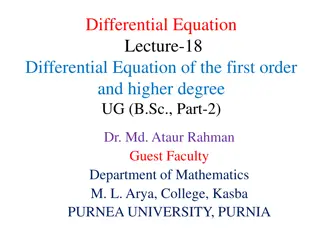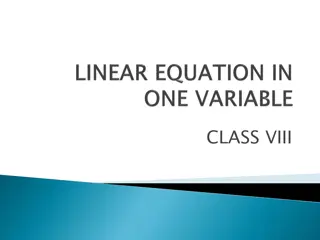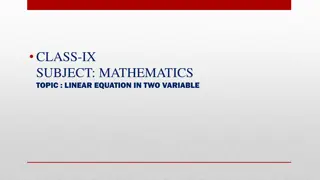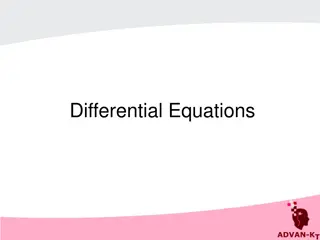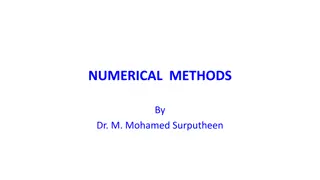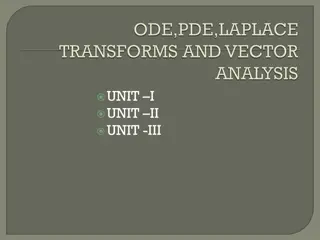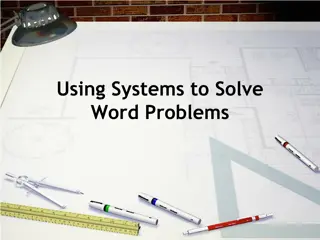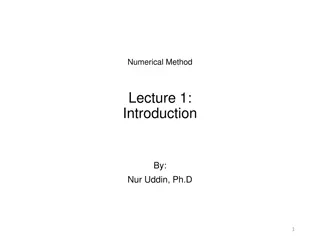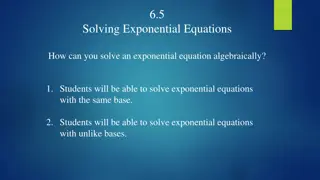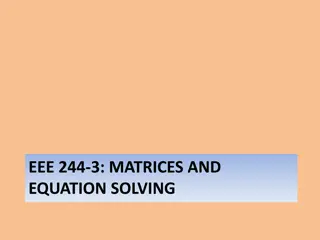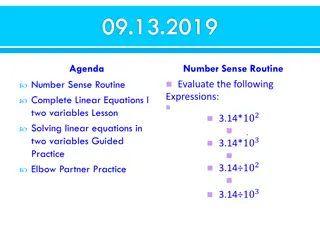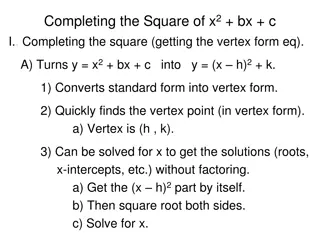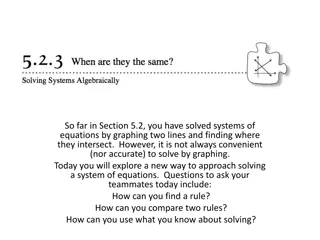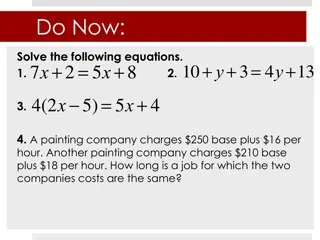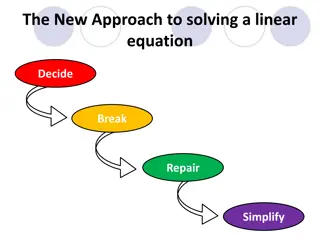Solving Systems of Equations: New Methods and Applications
The content discusses various methods for solving systems of equations, including substitution and elimination methods. It presents real-world problems involving money, sales figures, and fishing competitions to demonstrate the application of these methods. Readers will learn how to apply these techniques efficiently and explore new solution methods for linear equations in standard form.
Download Presentation

Please find below an Image/Link to download the presentation.
The content on the website is provided AS IS for your information and personal use only. It may not be sold, licensed, or shared on other websites without obtaining consent from the author.If you encounter any issues during the download, it is possible that the publisher has removed the file from their server.
You are allowed to download the files provided on this website for personal or commercial use, subject to the condition that they are used lawfully. All files are the property of their respective owners.
The content on the website is provided AS IS for your information and personal use only. It may not be sold, licensed, or shared on other websites without obtaining consent from the author.
E N D
Presentation Transcript
Thursday November 14 1. Janelle has $20 and is saving $6 per week. April has $150 and is spending $4 per week. When will they both have the same amount of money? 2. The sales of Gizmo Sports Drink at the local supermarket are currently 6,500 bottles per month. Since New Age Refreshers were introduced, sales of Gizmo have been declining by 55 bottles per month. New Age currently sells 2,200 bottles per month and its sales are increasing by 250 bottles per month. If these rates of change remain the same, in about how many months will the sales for both companies be the same? How many bottles will each company be selling at that time?
In this chapter, you have learned the substitution method for solving systems of equations. You also studied how to set two equations equal to each other. But are these methods the best to use for all types of systems? Today you will develop a new solution method that can save time for systems of linear equations in standard form, ax + by = c.
4-55. Jeanette is trying to find the intersection point of these two equations: 3y + 2x = 2 3y + 5x = 16 She has decided to use substitution to find the point of intersection. Her plan is to solve the first equation for y, and then to substitute the result into the second equation. Use Jeanette s idea to solve the system.
4-56. AVOIDING THE MESS: THE ELIMINATION METHOD Your class will now discuss a new method, called the Elimination Method, to find the solution to Jeanette's problem without the complications and fractions of the previous problem.
4-57. Pat was in a fishing competition at Lake Pisces. He caught some bass and some trout. Each bass weighed 3 pounds, and each trout weighed 1 pound. Pat caught a total of 30 pounds of fish. He got 5 points in the competition for each bass, but since trout are endangered in Lake Pisces, he lost 1 point for each trout. Pat scored a total of 42 points. a) Write a system of equations representing the information in this problem. b) Is this system a good candidate for the Elimination Method? Why or why not? c) Solve this system to find out how many bass and trout Pat caught. Be sure to record your work and check your answer by substituting your solution into the original equations.
4-58. ANNIE NEEDS YOUR HELP Annie was going to use the elimination method. She was ready to add the same value to both sides of the equation to eliminate the x-terms when she noticed a problem: Both x-terms are positive! 2x + 7y = 13 2x + 3y = 5 With your team, figure out something you could do that would allow you to add the value of the second equation to the first equation and eliminate the x-terms. Once you have figured out a method, solve the system and check your solution. Be ready to share your method with the class.
4-59. Find the point of intersection of each pair of lines below. Show your steps algebraically. Check each solution when you are finished. a) 2y x = 5 3y + x = 9 b) 2x 4y = 14 4y x = 3 c) 3x + 4y = 1 2x + 4y = 2
Systems of Linear Equations A system of linear equations is a set of two or more linear equations that are given together, such as the example at right: y = 2x y = 3x + 5 If the equations come from a real-world context, then each variable will represent some type of quantity in both equations. For example, in the system of equations above, y could stand for a number of dollars in both equations and x could stand for the number of weeks.
To represent a system of equations graphically, you can simply graph each equation on the same set of axes. The graph may or may not have a point of intersection, as shown circled at right.
Also notice that the point of intersection lies on both graphs in the system of equations. This means that the point of intersection is a solution to both equations in the system. For example, the point of intersection of the two lines graphed above is (1, 2). This point of intersection makes both equations true, as shown at right. y = 3x + 5 (2) = 3(1) + 5 2 = 3 + 5 2 = 2 y = 2x (2) = 2(1) 2 = 2 The point of intersection makes both equations true; therefore the point of intersection is a solution to both equations. For this reason, the point of intersection is sometimes called a solution to the system of equations.



